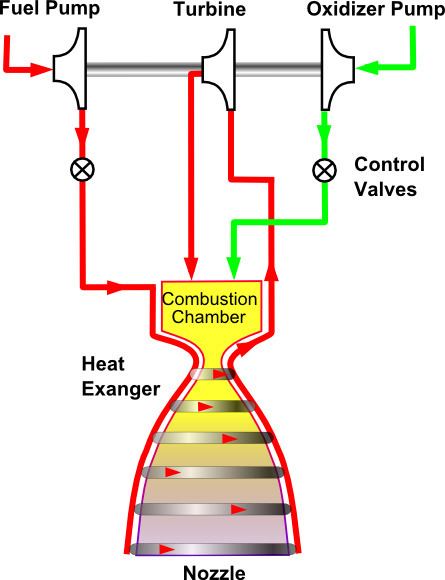 | ||
The expander cycle is a power cycle of a bipropellant rocket engine. In this cycle, the fuel is used to cool the engine's combustion chamber, picking up heat and changing phase. The heated, now gaseous, fuel then powers the turbine that drives the engine's fuel and oxidizer pumps before being injected into the combustion chamber and burned.
Contents
Because of the necessary phase change, the expander cycle is thrust limited by the square-cube rule. As the size of a bell-shaped nozzle increases with increasing thrust, the nozzle surface area (from which heat can be extracted to expand the fuel) increases as the square of the radius. However, the volume of fuel that must be heated increases as the cube of the radius. Thus there exists a maximum engine size of approximately 300 kN of thrust beyond which there is no longer enough nozzle area to heat enough fuel to drive the turbines and hence the fuel pumps. Higher thrust levels can be achieved using a bypass expander cycle where a portion of the fuel bypasses the turbine and or thrust chamber cooling passages and goes directly to the main chamber injector. Non-toroidal aerospike engines do not suffer from the same limitations because the linear shape of the engine is not subject to the square-cube law. As the width of the engine increases, both the volume of fuel to be heated and the available thermal energy increase linearly, allowing arbitrarily wide engines to be constructed. All expander cycle engines need to use a cryogenic fuel such as hydrogen, methane, or propane that easily reach their boiling points.
Some expander cycle engines may use a gas generator of some kind to start the turbine and run the engine until the heat input from the thrust chamber and nozzle skirt increases as the chamber pressure builds up.
In an open cycle, or "bleed" expander cycle, only some of the fuel is heated to drive the turbines, which is then vented to atmosphere to increase turbine efficiency. While this increases power output, the dumped fuel leads to a decrease in propellant efficiency (lower engine specific impulse). A closed cycle expander engine sends the turbine exhaust to the combustion chamber (see image at right.)
Some examples of an expander cycle engine are the Pratt & Whitney RL10 and RL60 and the Vinci engine for the future Ariane 6.
Expander bleed cycle (open cycle)
This operational cycle is a modification of the traditional expander cycle. In the bleed (or open) cycle, instead of routing heated propellant through the turbine and sending it back to be combusted, only a small portion of the propellant is heated and used to drive the turbine and is then bled off, being vented overboard without going through the combustion chamber. Bleeding off the turbine exhaust allows for a higher turbopump output by decreasing backpressure and maximizing the pressure drop through the turbine. Compared with a standard expander cycle, this leads to higher engine thrust at the cost of sacrificing some efficiency due to essentially wasting the bled propellant by not combusting it.
Dual expander (close cycle)
In a similar way that the staged combustion can be implemented separately on the oxidizer and fuel on the full flow cycle, the expander cycle can be implemented on two separate paths as the dual expander cycle. The use of hot gases of the same chemistry as the liquid for the turbine and pump side of the turbopumps eliminates the need for purges and some failures modes. Additionally, when the density of the fuel and oxidizer is significantly different, like in the H2/LOX case, the optimal turbopump speed differ so much that they need a gearbox between the fuel and oxidizer pumps. The use of dual expander cycle, with separate turbines, eliminates this failure-prone piece of equipment.
Dual expander cycle can be implemented by either using separated sections on the regenerative cooling system for the fuel and the oxidizer, or by using a single fluid for cooling and a heat exchanger to boil the second fluid. In the first case, for example, you could use the fuel to cool the combustion chamber, and the oxidizer to cool the nozzle. In the second case, you could use the fuel to cool the whole engine and a heat exchanger to boil the oxidizer.
Advantages
The expander cycle has a number of advantages over other designs:
Usage
Expander cycle engines include the following:
Expander Bleed cycle engines have been used in:
